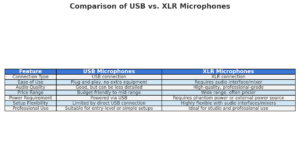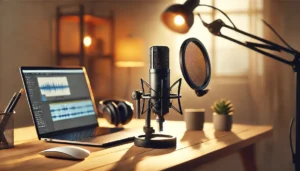Best Budget Microphones for Home Recording: Top Picks and Essential Tips
Recording high-quality audio at home no longer requires a huge investment. With an ever-growing range of budget-friendly microphones, anyone can capture professional-sounding vocals, podcasts, or streaming audio from the comfort of their own space. In this guide, we’ll explore the top budget microphones for home recording, covering their features, pros, cons, and practical setup tips.
USB vs. XLR: Which Should You Choose?
When hunting for a budget microphone, the first big decision is often between a USB or XLR microphone.
- USB Microphones
- Pros: Plug-and-play simplicity, no external audio interface required, perfect for beginners.
- Cons: Less expandable if you want to upgrade your gear in the future.
- XLR Microphones
- Pros: Scalable setup; works with mixers and audio interfaces; generally robust signal quality.
- Cons: Requires an audio interface (additional cost) and more setup time.

Understanding Condenser vs. Dynamic
- Condenser Microphones
- Highly sensitive and detailed, capturing crisp audio—ideal for vocals and acoustic instruments.
- More prone to background noise, so best used in quiet environments.
- Dynamic Microphones
- Less sensitive, perfect for untreated spaces or where background noise is a concern.
- Often more durable, which can be great for live performances or travel.
Key Features to Consider
- Polar Pattern
- A cardioid pattern (common in many budget mics) focuses on sound from the front, reducing ambient noise.
- Frequency Response
- Aim for a range around 20Hz–20kHz for capturing a full spectrum of audio detail.
- Build Quality
- Metal housings typically last longer. Read reviews to confirm if the mic holds up over time.
[INSERT VISUAL: An infographic illustrating polar patterns in a microphone diagram]
- Alt text: “Diagram showing how a cardioid polar pattern captures sound primarily from the front.”
Top 5 Budget Microphone Picks
Below are five popular budget microphones that consistently receive high ratings from home recording enthusiasts.
1. Samson Q2U (Dynamic, USB/XLR)
- Price: $60–$70
- Why It’s Great:
- Dual connectivity (USB and XLR) for extra flexibility.
- Durable and offers a decent, warm sound for vocals, podcasts, and live streaming.
[INSERT VISUAL: Photo of Samson Q2U microphone package]
- Alt text: “Samson Q2U microphone with its accessories, including the mic clip and USB cable.”
2. Audio-Technica AT2020 (Condenser, XLR)
- Price: $99–$120
- Why It’s Great:
- Delivers clear, detailed audio quality often heard in pro studios.
- Ideal for singers, instrumentalists, and voice-over artists.
3. Blue Snowball iCE (Condenser, USB)
- Price: $50–$70
- Why It’s Great:
- Extremely user-friendly; just plug into your computer and go.
- Popular for podcasting, YouTube videos, and casual voice recording.
4. Behringer C-1 (Condenser, XLR)
- Price: $50–$60
- Why It’s Great:
- A reliable, low-cost option for beginners who want to explore XLR.
- Solid for vocals and basic instrument recording, though it benefits from a decently quiet room.
5. Rode NT-USB Mini (Condenser, USB)
- Price: $99–$120
- Why It’s Great:
- Sturdy build and compact design; includes a built-in pop filter.
- Great choice if you need a smaller footprint on your desk.
Practical Setup Tips
Even the best microphone can only do so much in a poor recording environment. Here are some ways to maximize sound quality:
- Positioning
- Keep your mic 6–12 inches from your mouth for clear, warm audio.
- Use a pop filter to reduce harsh ‘p’ and ‘b’ sounds.
- Acoustic Treatment
- Hang heavy curtains, use acoustic panels, or even DIY options like moving blankets to reduce reflections.
- Avoid recording near noisy appliances or open windows if possible.
- Software & Workflow
- Start with free or low-cost DAWs like Audacity or Reaper.
- Check your recording levels, aiming for peaks between -12dB and -6dB to avoid clipping.
[INSERT VISUAL: An infographic of a basic home studio setup]
- Alt text: “Diagram showing a microphone on a stand with a pop filter, acoustic panels on walls, and a computer with recording software open.”
Conclusion & Recommendations
Choosing the right budget microphone depends on your immediate needs and whether you plan to expand your gear later:
- USB Microphones (e.g., Blue Snowball iCE, Rode NT-USB Mini, Samson Q2U) are great for a quick, plug-and-play setup.
- XLR Microphones (e.g., Audio-Technica AT2020, Behringer C-1) shine if you’ll eventually invest in a more advanced home studio.
No matter which mic you choose, remember that room acoustics and proper technique play just as big a role in capturing quality audio. Take the time to position your mic correctly, monitor your input levels, and reduce ambient noise wherever possible.
[INSERT VISUAL: A simple “cheat sheet” graphic summarizing each mic choice and its best use case]
- Alt text: “Cheat sheet comparing Samson Q2U, Audio-Technica AT2020, Blue Snowball iCE, Behringer C-1, and Rode NT-USB Mini in a quick-reference chart.”
Ready to upgrade your home recording setup? Pick one of these budget-friendly microphones and start creating professional-sounding audio for your podcasts, music, or voice-overs today. Don’t forget to explore pop filters, mic stands, and basic acoustic treatments for the best results!
